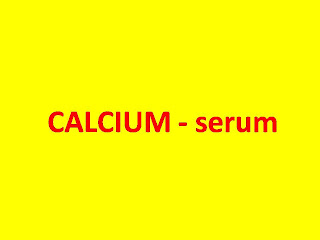CALCIUM - serum
Application:
Diagnosis/investigation of patients with clinical features of hypercalcemia or other features of hyperparathyroidism; malignancy esp lung, multiple myeloma, kidney, bony metastases; sarcoidosis: vitamin D or vitamin A toxicity.
Diagnosis/investigation of patients with clinical features of hypocalcemia or other features of hypoparathyroidism, renal failure, osteomalacia or rickets.
Evaluation of patients after thyroid or parathyroid surgery, or during massive blood transfusion.
Explanation: Calcium in the blood exists in ionized (free) and protein bound forms (bound to albumin). It can be measured as total calcium, ionized calcium, or corrected calcium (in which total calcium is corrected, usually in relation to the patient’s albumin level).
Serum calcium should be measured with serum albumin.
Corrected calcium depends on correction algorithm, typically:
corrected calcium (mg/dL) =
total calcium (mg/dL) +
0.02 (40 - albumin [g/L]).
Ionized calcium is generally required only if protein-bound calcium is likely to be very high (eg during massive transfusion), if pH is abnormal, or if an abnormality in calcium is marginal.
Specimen: 7 ml blood in a red-top tube
Reference Interval:
Total calcium:
9-10.5 mg/dL (Adult)
8.8-10.8 mg/dL (Child)
9-10.6 mg/dL (10 days-2 yrs.)
7.6-10.4 mg/dL (Neonate)
Ionized calcium:
4.5-5.6 mg/dL (Adult)
4.8-5.52 mg/dL (2 mos.-18 yrs.)
4.2-5.58 mg/dL (Neonate)
Application:
Diagnosis/investigation of patients with clinical features of hypercalcemia or other features of hyperparathyroidism; malignancy esp lung, multiple myeloma, kidney, bony metastases; sarcoidosis: vitamin D or vitamin A toxicity.
Diagnosis/investigation of patients with clinical features of hypocalcemia or other features of hypoparathyroidism, renal failure, osteomalacia or rickets.
Evaluation of patients after thyroid or parathyroid surgery, or during massive blood transfusion.
Explanation: Calcium in the blood exists in ionized (free) and protein bound forms (bound to albumin). It can be measured as total calcium, ionized calcium, or corrected calcium (in which total calcium is corrected, usually in relation to the patient’s albumin level).
Serum calcium should be measured with serum albumin.
Corrected calcium depends on correction algorithm, typically:
corrected calcium (mg/dL) =
total calcium (mg/dL) +
0.02 (40 - albumin [g/L]).
Ionized calcium is generally required only if protein-bound calcium is likely to be very high (eg during massive transfusion), if pH is abnormal, or if an abnormality in calcium is marginal.
Specimen: 7 ml blood in a red-top tube
Reference Interval:
Total calcium:
9-10.5 mg/dL (Adult)
8.8-10.8 mg/dL (Child)
9-10.6 mg/dL (10 days-2 yrs.)
7.6-10.4 mg/dL (Neonate)
Ionized calcium:
4.5-5.6 mg/dL (Adult)
4.8-5.52 mg/dL (2 mos.-18 yrs.)
4.2-5.58 mg/dL (Neonate)

0 comments:
Post a Comment